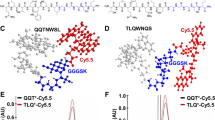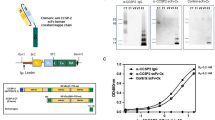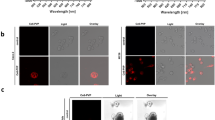Abstract
Colon cancer prevention currently relies on colonoscopy using white light to detect and remove polyps, but small and flat polyps are difficult to detect and frequently missed when using this technique. Fluorescence colonoscopy combined with a fluorescent probe specific for a polyp biomarker may improve polyp detection. Here we describe GE-137, a water-soluble probe consisting of a 26–amino acid cyclic peptide that binds the human tyrosine kinase c-Met conjugated to a fluorescent cyanine dye. Intravenous administration of GE-137 leads to its accumulation specifically in c-Met–expressing tumors in mice, and it is safe and well tolerated in humans. Fluorescence colonoscopy in patients receiving intravenous GE-137 enabled visualization of all neoplastic polyps that were visible with white light (38), as well as an additional nine polyps that were not visible with white light. This first-in-human pilot study shows that molecular imaging using an intravenous fluorescent agent specific for c-Met is feasible and safe, and that it may enable the detection of polyps missed by other techniques.
This is a preview of subscription content, access via your institution
Access options
Subscribe to this journal
Receive 12 print issues and online access
$209.00 per year
only $17.42 per issue
Buy this article
- Purchase on Springer Link
- Instant access to full article PDF
Prices may be subject to local taxes which are calculated during checkout





Similar content being viewed by others
References
Jemal, A. et al. Global cancer statistics. CA Cancer J. Clin. 61, 69–90 (2011).
Atkin, W.S. et al. Once-only flexible sigmoidoscopy screening in prevention of colorectal cancer: a multicentre randomised controlled trial. Lancet 375, 1624–1633 (2010).
Baxter, N.N. et al. Association of colonoscopy and death from colorectal cancer. Ann. Intern. Med. 150, 1–8 (2009).
Brenner, H. et al. Protection from right- and left-sided colorectal neoplasms after colonoscopy: population-based study. J. Natl. Cancer Inst. 102, 89–95 (2010).
Kaminski, M.F. et al. Quality indicators for colonoscopy and the risk of interval cancer. N. Engl. J. Med. 362, 1795–1803 (2010).
Kahi, C.J., Hewett, D.G., Norton, D.L., Eckert, G.J. & Rex, D.K. Prevalence and variable detection of proximal colon serrated polyps during screening colonoscopy. Clin. Gastroenterol. Hepatol. 9, 42–46 (2011).
van Rijn, J.C. et al. Polyp miss rate determined by tandem colonoscopy: a systematic review. Am. J. Gastroenterol. 101, 343–350 (2006).
Clapper, M.L. et al. Detection of colorectal adenomas using a bioactivatable probe specific for matrix metalloproteinase activity. Neoplasia 13, 685–691 (2011).
Marten, K. et al. Detection of dysplastic intestinal adenomas using enzyme-sensing molecular beacons in mice. Gastroenterology 122, 406–414 (2002).
Endlicher, E. et al. Hexaminolevulinate-induced fluorescence endoscopy in patients with rectal adenoma and cancer: a pilot study. Gastrointest. Endosc. 60, 449–454 (2004).
Hsiung, P.-L. et al. Detection of colonic dysplasia in vivo using a targeted heptapeptide and confocal microendoscopy. Nat. Med. 14, 454–458 (2008).
Fearon, E.R. & Vogelstein, B. A genetic model for colorectal tumorigenesis. Cell 61, 759–767 (1990).
Di Renzo, M.F. et al. Overexpression and amplification of the met/HGF receptor gene during the progression of colorectal cancer. Clin. Cancer Res. 1, 147–154 (1995).
Nanjappan, A.K.S. et al. Peptides that specifically bind HGF receptor (cMet) and uses thereof. Patent no. WO 2004/078778 A2. (2004).
Moestue, S. et al. Whole-body section fluorescence imaging—a novel method for tissue distribution studies of fluorescent substances. Contrast Media Mol. Imaging 4, 73–80 (2009).
van den Berg, N.S., Buckle, T., Kuil, J., Wesseling, J. & van Leeuwen, F.W.B. Immunohistochemical detection of the CXCR4 expression in tumor tissue using the fluorescent peptide antagonist Ac-TZ14011-FITC. Transl. Oncol. 4, 234–240 (2011).
Kiesslich, R., Goetz, M., Hoffman, A. & Galle, P.R. New imaging techniques and opportunities in endoscopy. Nat. Rev. Gastroenterol. Hepatol. 8, 547–553 (2011).
Adler, A. et al. A prospective randomised study on narrow-band imaging versus conventional colonoscopy for adenoma detection: does narrow-band imaging induce a learning effect? Gut 57, 59–64 (2008).
Kuiper, T. et al. Endoscopic trimodal imaging detects colonic neoplasia as well as standard video endoscopy. Gastroenterology 140, 1887–1894 (2011).
Mayinger, B., Neumann, F., Kastner, C., Haider, T. & Schwab, D. Hexaminolevulinate-induced fluorescence colonoscopy versus white light endoscopy for diagnosis of neoplastic lesions in the colon. Endoscopy 42, 28–33 (2010).
Keller, R., Winde, G., Terpe, H.J., Foerster, E.C. & Domschke, W. Fluorescence endoscopy using a fluorescein-labeled monoclonal antibody against carcinoembryonic antigen in patients with colorectal carcinoma and adenoma. Endoscopy 34, 801–807 (2002).
Foersch, S. et al. Molecular imaging of VEGF in gastrointestinal cancer in vivo using confocal laser endomicroscopy. Gut 59, 1046–1055 (2010).
Goetz, M. & Wang, T.D. Molecular imaging in gastrointestinal endoscopy. Gastroenterology 138, 828–833 (2010).
Wu, A.M. & Olafsen, T. Antibodies for molecular imaging of cancer. Cancer J. 14, 191–197 (2008).
Chen, K. & Chen, X. Design and development of molecular imaging probes. Curr. Top. Med. Chem. 10, 1227–1236 (2010).
Liu, Z., Miller, S.J., Joshi, B.P. & Wang, T.D. In vivo targeting of colonic dysplasia on fluorescence endoscopy with near-infrared octapeptide. Gut 62, 395–403 (2013).
Mitsunaga, M. et al. Fluorescence endoscopic detection of murine colitis-associated colon cancer by topically applied enzymatically rapid-activatable probe. Gut 62, 1179–1186 (2013).
Imaizumi, K. et al. Dual-wavelength excitation of mucosal autofluorescence for precise detection of diminutive colonic adenomas. Gastrointest. Endosc. 75, 110–117 (2012).
Rex, D.K. Reducing costs of colon polyp management. Lancet Oncol. 10, 1135–1136 (2009).
Leggett, B. & Whitehall, V. Role of the serrated pathway in colorectal cancer pathogenesis. Gastroenterology 138, 2088–2100 (2010).
Wielenga, V.J. et al. Expression of c-Met and heparan-sulfate proteoglycan forms of CD44 in colorectal cancer. Am. J. Pathol. 157, 1563–1573 (2000).
van der Poel, H.G., Buckle, T., Brouwer, O.R., Valdes Olmos, R.A. & van Leeuwen, F.W. Intraoperative laparoscopic fluorescence guidance to the sentinel lymph node in prostate cancer patients: clinical proof of concept of an integrated functional imaging approach using a multimodal tracer. Eur. Urol. 60, 826–833 (2011).
Acknowledgements
The authors would like to acknowledge the contributions of T. Attramadal, E. Johannesen and H. Dirven, who were the Project Leaders at GE Healthcare in the screening, lead selection and the translational/early clinical phases of the project, respectively. GE Healthcare AS received support for the GE-137 project from The Research Council of Norway grant no. 192984/BIA and SkatteFUNN grant no. 201108. F.W.B.v.L. and T.B. were supported by the The Netherlands Organisation for Scientific Research (NWO) VIDI (grant no. STW BGT11272) and a Postdoctoral Molecular Imaging Scholarship from the Education and Research Foundation for Nuclear Medicine and Molecular Imaging.
Author information
Authors and Affiliations
Contributions
J.B., I.M.C.K. and P.B.G. designed the pharmacological studies; B.I., M.S.-N. and L.-I.Ø. developed the probe and the drug product; and R.B., R.M.B., S.A.M., A.H. and G.T.D. conducted the preclinical testing. L.S. and A.J.K. performed recruitment and safety testing for the clinical studies. M.L.d.K. performed the statistical analyses. H.M. performed the histopathological analysis of polyps. M.V.W. performed the c-Met immunohistochemical analysis. F.W.B.v.L., P.W.V. and T.B. performed the ex vivo direct fluorescence imaging studies. A.H., S.Y. and G.T. designed the method for assessing the imaging characteristics of the probe and developed the colonoscopy system. P.B.G., A.M.J.L. and J.C.H.H. designed the clinical studies, A.M.J.L. and J.C.H.H. performed the clinical studies, and J.C.H.H. wrote the manuscript.
Corresponding author
Ethics declarations
Competing interests
P.B. Gordon, R. Bendiksen, B. Indrevoll, R.M. Bjerke, S.A. Moestue, S. Yazdanfar, G. Torheim, M. Swaerd-Nordmo, G.T. Dalsgaard, L.-I. Ødegårdstuen and A. Healey are all currently employed by GE Healthcare or were employed by GE Healthcare during the study. The following authors declare no conflict of interest: J. Burggraaf, I.M.C. Kamerling, L. Schrier, M.L. de Kam, A.J. Kales, A.M.J. Langers, M.V. Warren, H. Morreau, P.W. Voorneveld, T. Buckle, F.W.B. van Leeuwen, and J.C.H. Hardwick.
Supplementary information
Supplementary Text and Figures
Supplementary Figures 1–6, Supplementary Tables 1–4 & Supplementary Methods (PDF 4164 kb)
Supplementary Video 1
Video showing the two endoscopic images obtained simultaneously with white light and with near infrared fluorescence imaging (Green image) from a patient at colonoscopy. The first frame of the video details the characteristics of the colonic polyp shown in the video. (AVI 2485 kb)
Supplementary Video 2
Video showing the two endoscopic images obtained simultaneously with white light and with near infrared fluorescence imaging (Green image) from a patient at colonoscopy. The first frame of the video details the characteristics of the colonic polyp shown in the video (AVI 2531 kb)
Supplementary Video 3
Video showing the two endoscopic images obtained simultaneously with white light and with near infrared fluorescence imaging (Green image) from a patient at colonoscopy. The first frame of the video details the characteristics of the colonic polyp shown in the video (AVI 2577 kb)
Supplementary Video 4
Video showing the two endoscopic images obtained simultaneously with white light and with near infrared fluorescence imaging (Green image) from a patient at colonoscopy. The first frame of the video details the characteristics of the colonic polyp shown in the video (AVI 2368 kb)
Rights and permissions
About this article
Cite this article
Burggraaf, J., Kamerling, I., Gordon, P. et al. Detection of colorectal polyps in humans using an intravenously administered fluorescent peptide targeted against c-Met. Nat Med 21, 955–961 (2015). https://doi.org/10.1038/nm.3641
Received:
Accepted:
Published:
Issue Date:
DOI: https://doi.org/10.1038/nm.3641
This article is cited by
-
Fluorescence image-guided tumour surgery
Nature Reviews Bioengineering (2023)
-
Wide-field endoscope accessory for multiplexed fluorescence imaging
Scientific Reports (2023)
-
Molecular and functional imaging in cancer-targeted therapy: current applications and future directions
Signal Transduction and Targeted Therapy (2023)
-
Highlighting the Undetectable — Fluorescence Molecular Imaging in Gastrointestinal Endoscopy
Molecular Imaging and Biology (2023)
-
Feasibility of fluorescence imaging at microdosing using a hybrid PSMA tracer during robot-assisted radical prostatectomy in a large animal model
EJNMMI Research (2022)



